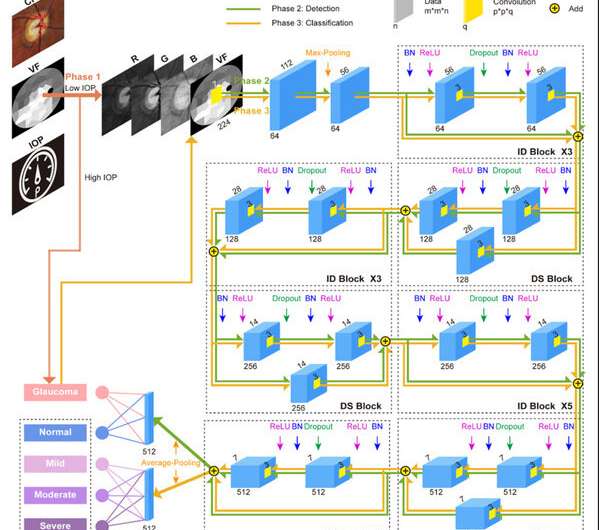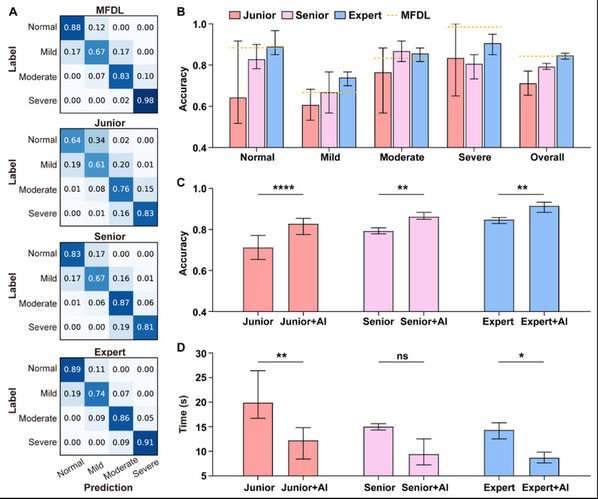New progress in bioimaging based on multi-feature deep learning

Deep learning plays an increasingly crucial role in biomedical research, due to its exceptional data processing capacity. However, single-feature data is far from enough to present the full picture of an issue.
Recently, a multi-feature deep learning system was proposed by Prof. Si Ke's group from Zhejiang University and successfully applied in accurate glaucoma severity diagnosis.
Glaucoma is the leading cause of irreversible blindness. However, manual assessment of the glaucoma is labor intensive and highly dependent on image interpretation by trained specialists, which restricts the wide glaucoma screening in the general population. Recently, single-feature deep learning has shown considerable promise in glaucoma diagnosis.
However, several studies have demonstrated that there may be disagreement between structural and functional measurements in glaucoma patients, which may cause false negative results. Current multi-feature deep learning methods in glaucoma diagnosis mainly focus on distinguishing health and glaucoma without further identification of the severity of glaucoma, leading to very limited significance for clinical treatment guidance.
Prof. Si Ke's group published their article titled "A multi-feature deep learning system to enhance glaucoma severity diagnosis with high accuracy and fast speed" in the journal Biomedical Informatics on November 3. They proposed a multi-feature deep learning (MFDL) system based on intraocular pressure (IOP), color fundus photograph (CFP) and visual field (VF) to classify the glaucoma into four severity levels.
A three-phase framework of glaucoma screening, detection and classification is used to classify glaucoma into normal, mild, moderate and severe. The proposed model can potentially assist ophthalmologists in efficient and accurate glaucoma diagnosis that could aid the clinical management of glaucoma.

In the study, the researchers designed a three-phase framework for glaucoma severity diagnosis from coarse to fine, which contains screening, detection and classification. They trained it on 6,131 samples from 3,324 patients and tested it on independent 240 samples from 185 patients.
The results show that MFDL achieved a higher accuracy of 0.842 (95% CI, 0.795–0.888) than the direct four classification deep learning (DFC-DL, accuracy of 0.513 [0.449–0.576]), CFP-based single-feature deep learning (CFP-DL, accuracy of 0.483 [0.420–0.547]) and VF-based single-feature deep learning (VF-DL, accuracy of 0.725 [0.668–0.782]).
Its performance was statistically significantly superior to that of 8 juniors. It also outperformed 3 seniors and 1 expert, and was comparable with 2 glaucoma experts (0.842 vs. 0.854, p = 0.663; 0.842 vs. 0.858, p = 0.580). With the assistance of MFDL, junior ophthalmologists achieved statistically significantly higher accuracy performance, with the increased accuracy ranged from 7.50% to 17.9%, and that of seniors and experts were 6.30% to 7.50% and 5.40% to 7.50%. The mean diagnosis time per patient of MFDL was 5.96 s.
As an efficient auxiliary diagnostic tool, MFDL could assist ophthalmologists who are not specialized in glaucoma severity diagnosis, especially in remote and poor communities. It allows for rapid glaucoma screenings during primary care visits and provides individualized health care advices for glaucoma patients, which is a promising approach to benefit a wide patient population.
More information: Ying Xue et al, A multi-feature deep learning system to enhance glaucoma severity diagnosis with high accuracy and fast speed, Journal of Biomedical Informatics (2022). DOI: 10.1016/j.jbi.2022.104233

















